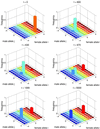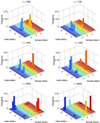Sympatric speciation by sexual conflict
- PMID: 12149438
- PMCID: PMC124966
- DOI: 10.1073/pnas.152011499
Sympatric speciation by sexual conflict
Abstract
It is well established that sexual conflict can drive an endless coevolutionary chase between the sexes potentially leading to genetic divergence of isolated populations and allopatric speciation. We present a simple mathematical model that shows that sexual conflict over mating rate can result in two other general regimes. First, rather than "running away" from males, females can diversify genetically into separate groups, effectively "trapping" the males in the middle at a state characterized by reduced mating success. Female diversification brings coevolutionary chase to the end. Second, under certain conditions, males respond to female diversification by diversifying themselves. This response results in the formation of reproductively isolated clusters of genotypes that emerge sympatrically.
Figures




References
-
- Parker G. A. (1979) in Sexual Selection and Reproductive Competition in Insects, eds. Blum, M. S. & Blum, N. A. (Academic, New York), pp. 123–166.
-
- Arnqvist G. & Rowe, L. (1995) Proc. R. Soc. London Ser B 261, 123-127.
-
- Chapman T. & Partridge, L. (1996) Proc. R. Soc. London Ser B 263, 755-759. - PubMed
-
- Stockley P. (1997) Trends Ecol. Evol. 12, 154-159. - PubMed
-
- Partridge L. & Hurst, L. D. (1998) Science 281, 2003-2008. - PubMed
Publication types
MeSH terms
LinkOut - more resources
Full Text Sources

